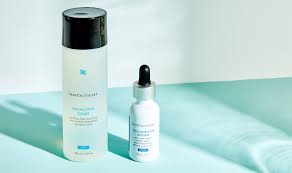
Are Serum and Toner the Same Thing? Let’s Clear Up the Confusion
Navigating the world of skincare can be overwhelming. With so many products and routines out there, it’s no wonder people often ask: Are serum and toner the same thing?
It’s a valid question, especially if you’re building your first skincare routine or trying to figure out what each product actually does.
Let’s break down the differences, benefits, and how to use them correctly—so your skin gets the most out of your efforts.
What Is a Serum and What Does It Do for Your Face?
Let’s start with serums, which are one of the most targeted skincare products you can use.
Serums are lightweight, fast-absorbing liquids that contain high concentrations of active ingredients. These actives are chosen to tackle specific concerns like:
Fine lines and wrinkles, Hyperpigmentation, Uneven texture, Dullness, Acne and breakouts, Dehydration
Think of a serum like a special delivery of nutrients directly to your skin.
They’re formulated to penetrate deep into the layers of the skin where they can stimulate collagen, fight free radicals, and restore the skin barrier.
Because serums are so concentrated, you only need a small amount—usually a few drops—applied before heavier products like moisturizers.
Key Benefits of Using a Serum
Here are the top benefits of adding a serum to your skincare routine:
Deep hydration with ingredients like hyaluronic acid that draw moisture into the skin
Brighter skin tone from vitamin C and niacinamide, which help fade dark spots and dullness
Anti-aging benefits through ingredients like peptides and retinol that firm and smooth
Enhanced skin barrier repair from ceramides and fatty acids
Improved absorption of follow-up products by prepping the skin
Serums can be a game-changer, especially if you’re targeting specific skin issues. However, not everyone needs a serum. If your skin is happy and healthy without it, you’re not doing anything wrong.
What Is a Toner and What Does It Do?
Now let’s talk about toners. These often get misunderstood or overlooked, especially by people who think they’re just glorified water. But toners have come a long way.
Traditionally, toners were used to remove any leftover cleanser, dirt, or oil after washing your face. They were usually alcohol-based and could feel harsh or drying—especially for sensitive skin.
Thankfully, modern toners are much more skin-friendly. Today’s formulas include hydrating, exfoliating, and balancing ingredients.
Depending on the formula, a toner can:
Remove any residue left after cleansing
Restore the skin’s pH balance
Gently exfoliate dead skin cells with AHAs or BHAs
Hydrate and soothe with aloe vera, rose water, or glycerin
Help other products absorb better by prepping the skin
Modern Toners Offer Targeted Skin Benefits
Different toners are designed for different skin types and concerns. Here are some examples:
Hydrating toners: Include ingredients like hyaluronic acid, rose water, or glycerin to provide extra moisture
Exfoliating toners: Contain glycolic acid, lactic acid, or salicylic acid to remove dead skin and clear pores
Balancing toners: Often include witch hazel, niacinamide, or green tea to calm oily or acne-prone skin
Soothing toners: With chamomile or calendula to reduce redness and sensitivity
So no, toner isn’t just water in a fancy bottle. It can play a vital role in prepping your skin for what comes next.
So… Are Toners and Serums the Same Thing?
No, serums and toners are not the same thing. They differ in purpose, texture, ingredients, and where they fit into your skincare routine.
Here’s a quick comparison:
Feature Toner Serum
Texture Light, watery Light but slightly thicker
Purpose Prepares skin, removes residue Delivers active ingredients
Use After cleansing After toner, before moisturizer
Targets pH balance, oil, exfoliation Aging, hydration, dullness
Common Ingredients AHAs, BHAs, botanical extracts Retinol, peptides, vitamin C
Toners prep your skin, while serums treat your skin. Think of toner as setting the stage and serum as delivering the performance.
Can You Use a Serum Without a Toner?
Yes, you can absolutely use a serum without a toner. While toner is helpful, it’s not essential in every skincare routine.
Here are some considerations:
If your cleanser is gentle and effective, a toner may not be needed to remove residue
Sensitive skin types may prefer to skip toners, especially exfoliating ones, to avoid overdoing it
Using too many actives at once can cause dryness or irritation, especially with strong acids or retinol
However, using a toner can still improve serum absorption, especially if you’re applying your products to damp skin. Just make sure the toner doesn’t irritate or conflict with the serum you’re using.
Can You Use Toner and Serum Together?
Yes—and in fact, they work beautifully together.
Using toner and serum together allows each product to do what it does best. The toner clears the way and balances the skin, and the serum dives deep to treat concerns.
Benefits of using toner and serum together include:
Enhanced product absorption
Layered skincare benefits from compatible ingredients
Gentler impact if a serum is applied over a soothing or hydrating toner
More visible results over time when layering actives and hydrators properly
For example, using a toner with glycolic acid to exfoliate, followed by a serum with vitamin C to brighten, gives your skin a serious glow-up.
Should You Apply Serum Before or After Toner?
Always apply toner before serum. Toner is part of the cleansing and prepping phase of your routine. Serum is part of the treatment phase.
Here’s the basic order of application:
Cleanser, Toner, Serum, Moisturizer, Sunscreen (in the morning)
Applying products from thinnest to thickest helps your skin absorb ingredients more efficiently. That’s why toners come before serums in every routine.
Do You Need Both Toner and Serum in Your Skincare Routine?
Not necessarily. You don’t have to use both if your skin doesn’t need both. But using both can enhance results if your skin has multiple concerns.
If you’re:
Dealing with dullness or uneven tone → Use a toner with exfoliating acids and a serum with vitamin C
Trying to fight aging signs → Use a hydrating toner and a serum with peptides or retinol
Struggling with breakouts → Try a salicylic acid toner and a niacinamide serum
The key is to listen to your skin and choose products that work well together. It’s not about using more—it’s about using the right combination.
Final Thoughts: Serum vs Toner—Know the Difference, Use Them Right
So, are serum and toner the same thing? Definitely not.
They each serve different purposes and bring unique benefits to your skincare routine. When used properly and paired wisely, they can make a big difference in the way your skin looks and feels.
Toners prepare and refresh the skin after cleansing
Serums deliver powerful actives deep into the skin to treat specific concerns
Whether you choose to use both or just one depends on your skin type, your goals, and how your skin responds to each product.
Quick Tips for Using Toners and Serums Together:
Apply toner to freshly cleansed skin using a cotton pad or your hands
Let toner fully absorb before applying your serum
Choose products with complementary ingredients (e.g. glycolic toner + vitamin C serum)
Avoid doubling up on strong actives unless your skin is used to it
Always apply moisturizer afterward to lock in hydration
Use SPF in the morning to protect skin, especially when using acids or retinol


